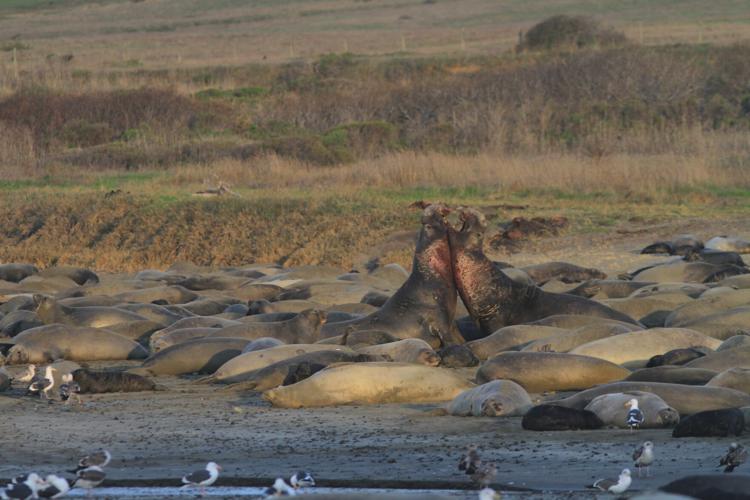After a quick hike in the mud across a soddened marine terrace, I found myself on a deserted central coast beach, driftwood and tangled bull kelp strewn below eroding bluffs. Besides the surf crashing on the lonely strand and clusters of sanderlings working the ebb and flow of the incoming tide, the only other sounds were those of northern elephant seals bellowing and whining just over a mile up the beach.
Once there, I tucked into a craggy alcove and observed all the elephant seal dynamics unfolding before me. Gulls waited patiently on the edge of the rookery. After a mother gives birth, the gulls go into a feeding frenzy trying to snatch the nutrient-rich placentas and umbilical cords from the offspring. It doesn’t stop there, as northern elephant seal bulls in various stages of maturity eke out territories with the hopes of mating with as many females as possible.
It’s entertaining to say the least, and with a high mortality rate for newborn pups, there are always turkey vultures roosting nearby. Nothing goes to waste on those gritty, cobbled shorelines. Even smaller shorebirds like black turnstones sneak between all the moms and babies, gobbling up whatever is edible. However, it’s the 15-foot-long, 3,000-to-5,000-pound bulls that dominated my curiosity.
Sleeping with one eye open
Most times, when observing northern elephant seals, they appear lazy and sleepy, but nothing could be further from the truth, The biggest bulls can be snoozing the day away, but they always seem to know when an interloper tries to mate with one of its females, even if that female is at the other end of the colony.
Having said that, there was a challenger up to the task. It was a bloody, relentless bout that started on a grassy meadow and finished in frothy surf along this deserted beach.
The two northern elephant seal bulls traded one blow after the other for just over an hour, a sunrise slugfest that was all out on a windswept beach loaded with females and hungry newborn pups.
During that time, the two blubbery adversaries hammered away at each other. The challenger plowed toward the beachmaster through the throngs of females and pups still sleepy-eyed from the night before. This upstart bull was starting its day off with a bang, taking on the largest and baddest bull on a beach 150 yards wide.
The stage was set for these two ginormous seals, the second largest in the world, to square off over territory and mating rights at the second largest rookery in the world for this species of marine mammal.
They each reared upward, and then lunged toward each other like giant inch worms. As they came together, it initiated the longest and bloodiest battle I’ve ever seen between two bull northern elephant seals, and I’ve been photographing them since the mid-1990s.
Bloody fury
When both reared up to commence battle, they were each seven or eight feet tall. Both bulls were well-equipped with the customary raw and scarred necks, a brutal testimony to their ongoing maturity. However, one bull was a few feet longer, and weighed more than the challenger, but for the most part it didn’t seem to matter. During that time span, neither seal gave ground.
It didn’t take long for each bull to bloody the other. With their enormous upper bodies, they’d rear up and then swing mightily at each other’s thick necks. On occasion, they’d swing at the lower body, hacking with their teeth. Both their floppy proboscises were also bloodied. Momentarily, they’d each get ahold of the other’s snout and tear it open. I was at least 75 yards to the south of them, but I could hear the dull thud every time one of the bulls connected with the other’s neck.
Change in venue
The fight that began on the grassy meadow near Highway 1, finished in the ocean in waist-to-chest-deep water. The surf was chest-high, but there was never a wave that budged the two adversaries. And there was never a break in the action, as both animals were bloodied from the get-go.
Any other seals that were in their way either inch-wormed out of their path or were trampled, as the bulls moved down to the wet sand. Once on the hard mud pack, I could almost feel the reverberations beneath my feet, as they continued trading powerful blows.
Once they did reach the surf, the immediate water around them fluctuated between light pink and bright red. Waves continued crashing over them, and several times they briefly fought underwater. I’m not sure how the victor was determined, but over that period, the larger male made the challenger backpedal to the surf. However, the challenger delivered as much damage as the beachmaster. Eventually, the two separated. The younger, slightly smaller bull turned toward open water, and the beachmaster returned to its territory and harem.
Maybe next year, if they survive, those two colossal bulls could meet again on this same ragged beach and the outcome might be different. Still, for roughly 75 minutes, two pelagic marine mammals showed no signs of giving in.






















(0) comments
Welcome to the discussion.
Log In
Keep it Clean. Please avoid obscene, vulgar, lewd, racist or sexually-oriented language.
PLEASE TURN OFF YOUR CAPS LOCK.
Don't Threaten. Threats of harming another person will not be tolerated.
Be Truthful. Don't knowingly lie about anyone or anything.
Be Nice. No racism, sexism or any sort of -ism that is degrading to another person.
Be Proactive. Use the 'Report' link on each comment to let us know of abusive posts.
Share with Us. We'd love to hear eyewitness accounts, the history behind an article.